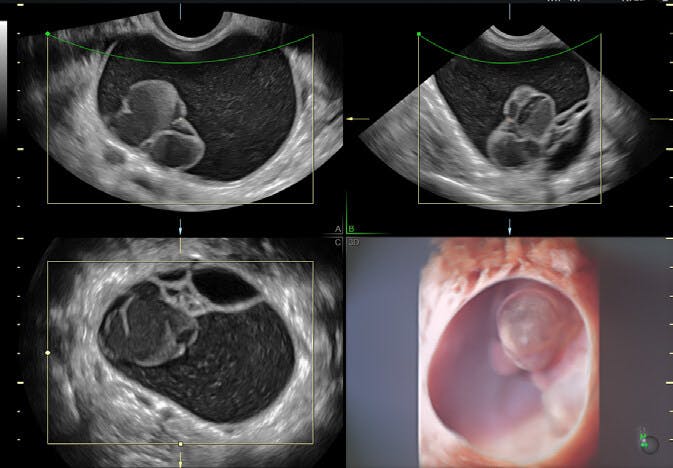Gynecology health issues affect women and girls of all ages, but the causes and course of action may change over time. For reproductive-aged women, timely, accurate diagnosis is essential to protect fertility in case of a serious condition.
3D ultrasound is a useful tool to help narrow down possibilities when patients have common complaints such as painful periods. Ultrasound also provides the imaging clarity needed to identify issues that can be difficult to diagnose, such as endometrial lesions, ovarian cysts and fibroids.
Here are some of the most common issues in gynecology that physicians can diagnose and treat early with the help of 3D ultrasound.
Pelvic Pain
Cramps are expected before and during a woman's period. But severe pain that lingers or occurs during sexual intercourse, bowel movements or urination could be a sign of endometriosis. Chronic pelvic pain may also indicate pelvic inflammatory disease, cysts or menstrual flow obstruction. Additionally, pelvic pain can stem from a gastrointestinal, genitourinary or musculoskeletal source.
OB/GYN providers use many diagnostic tools to narrow down specific causes of pelvic pain, including:
- Physical exams
- Lab tests, such as urinalysis, complete blood count (CBC), hormone assay and beta-human chorionic gonadotropin (hCG)
- Sexually transmitted disease tests
Ultrasound is a first-line imaging test that's more comfortable and convenient than MRI or CT scan.
Where 2D ultrasound provides general clues, 3D imaging gives physicians a clearer view of the pelvic region for the identification of lesions, inflammation, cysts and ectopic pregnancy.
Endometriosis
Severe, chronic abdominal pain that occurs before and after periods, during sexual intercourse, with bowel movements or during urination could indicate endometriosis. Diagnosis of this condition is often delayed by years despite symptoms that negatively impact quality of life. Early diagnosis and treatment may help prevent disease progression and help women return to life without pain sooner.
A pelvic ultrasound helps facilitate the diagnosis of endometrioma; however, laparoscopy and biopsy are often used to confirm the diagnosis. 3D ultrasound is an effective first-line tool for detecting endometriosis beyond the ovaries and for bowel lesions. It also provides valuable information for planning surgery.
Ovarian Cysts
Ovarian cysts are relatively common in reproductive-aged women. Most of the time, they release on their own. When they don't, they may require additional monitoring.
Simple ovarian cysts can be managed conservatively with transvaginal ultrasound. Complex ovarian cysts require more thorough testing to rule out cancer. Combining 3D transvaginal ultrasound with power Doppler assessment, a CA 125 blood test and a review of symptoms can help gynecologists determine whether the cysts are benign or cancerous. Doctors can also review images for signs of endometriosis, which can present with similar symptoms.
Uterine Fibroids
Uterine fibroids are common in reproductive-aged women. This condition impacts up to 70% of women worldwide and disproportionately affects women of color. In many cases, fibroids produce few to no symptoms. Symptoms that do occur include bleeding between periods, long-lasting periods, frequent urination and a feeling of pressure or fullness in the lower belly. If left untreated, fibroids can lead to anaemia and infertility.
3D ultrasound helps physicians visualize fibroid size, location and quantity. Treatment varies depending on the symptoms and a woman's desire to maintain fertility. For example, hormonal contraceptives are often used to control heavy bleeding, but nonsteroidal anti-inflammatory drugs may be a better option for women who want to become pregnant. Surgical options range from hysterectomy to myomectomy, the latter of which aims to remove tumors while preserving fertility.
Uterine Polyps
Bleeding between periods is a common sign of uterine polyps. Usually benign, uterine polyps typically manifest before or after menopause but rarely affect adolescent girls. If left untreated, polyps may impact future childbearing, though the evidence is conflicting.
3D transvaginal ultrasound is the most common way to evaluate endometrial thickening and the presence of polyps because it provides a clear view of the uterine cavity. Ultrasound also allows clinicians to monitor polyps over time.
Adenomyosis
Severe menstrual cramps, pelvic pain and heavy bleeding are characteristic signs of adenomyosis. It's challenging to diagnose and treat adenomyosis because it often coexists with other conditions and the symptoms mimic several other gynecologic conditions. Doing so, however, will help lower the risk of infertility and miscarriage.
MRI and transvaginal ultrasound are the most common imaging modalities used to diagnose adenomyosis. MRI has a sensitivity that ranges from 46.1 to 90% in detecting adenomyosis; however, it does not present a definable junctional zone in about 20% of premenopausal women.
Transvaginal ultrasound has a sensitivity of about 89% and can identify characteristic features of adenomyosis. It's also widely available in clinics and more cost-effective for patients than MRI.
Early Diagnosis and Treatment
Abnormal pelvic pain and bleeding in premenopausal women could indicate a benign medical condition. However, these symptoms could also signal a more serious case of uterine fibroids, endometriosis or ovarian cysts. Early diagnosis and treatment are key to lowering the risk of infertility in this population. 3D ultrasound provides the specificity and sensitivity needed to help gynecologists make confident diagnoses and help guide their patients down the path to wellness.




